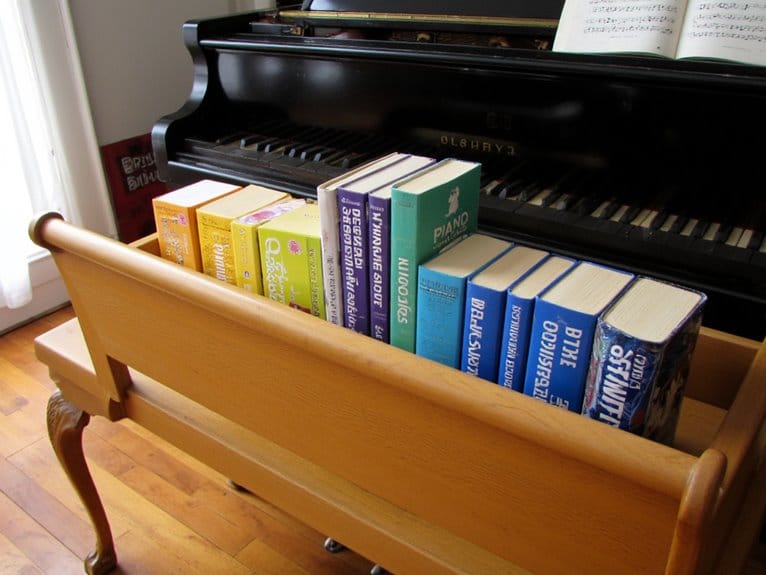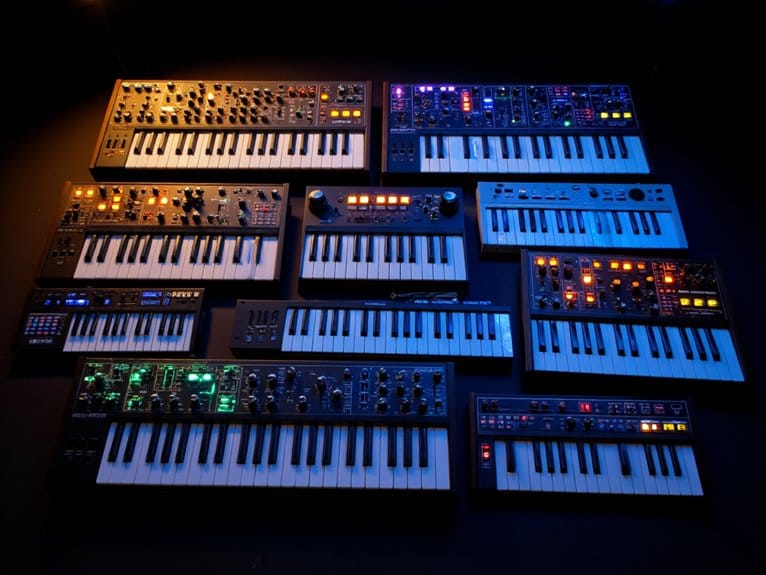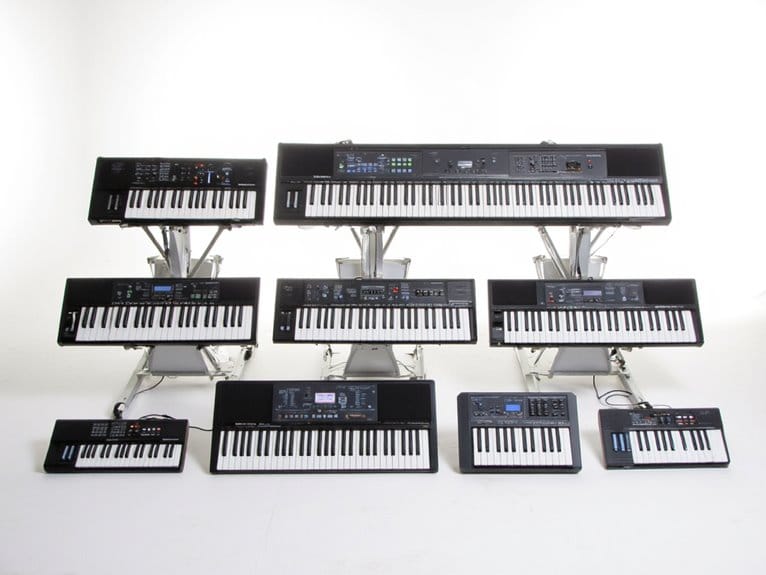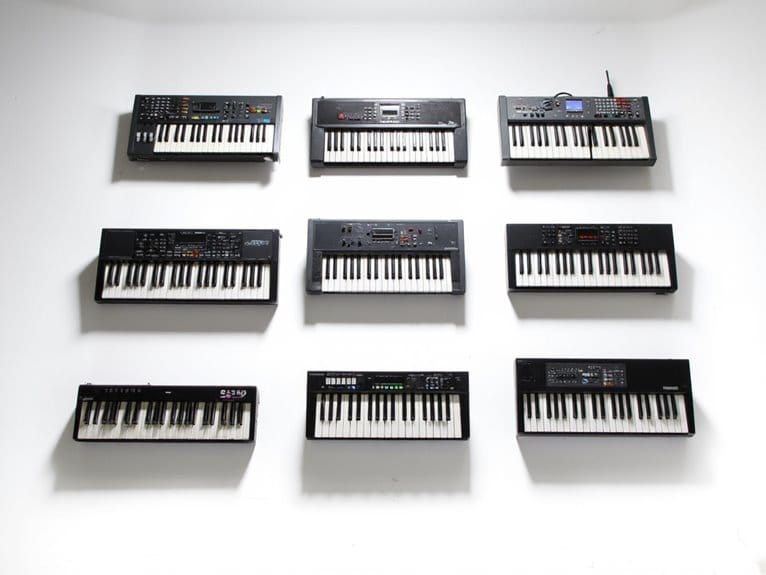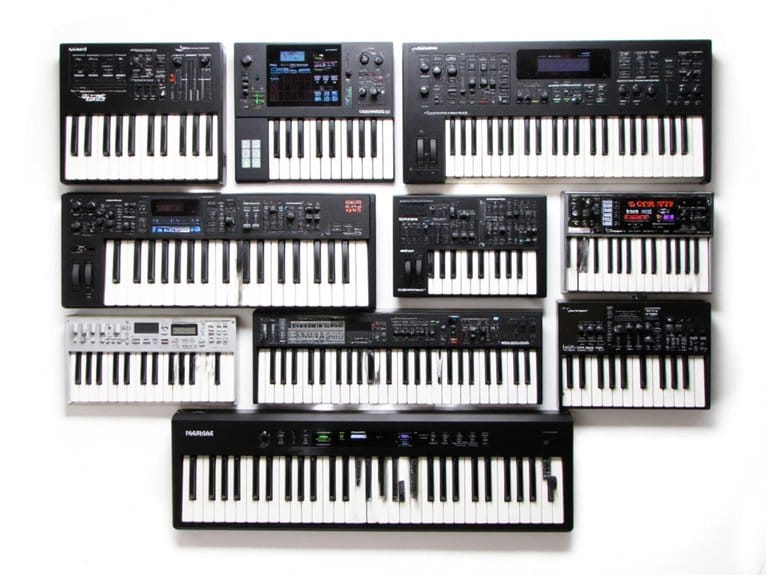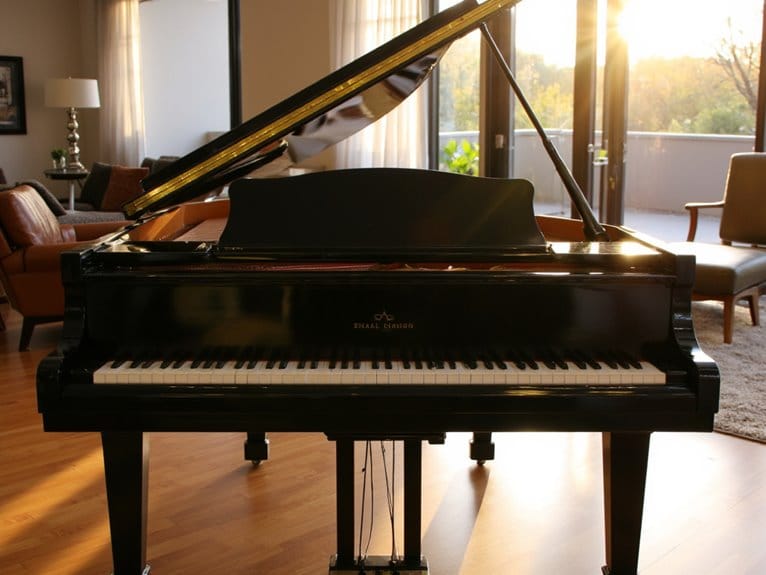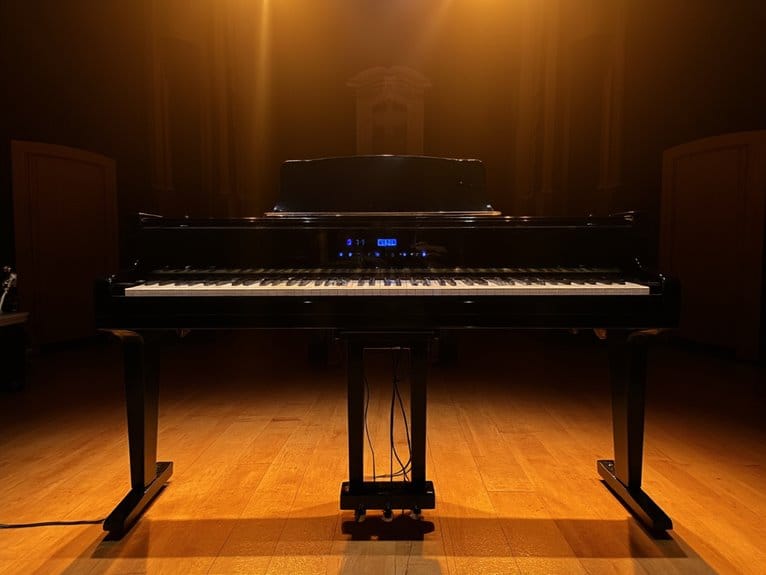10 Best Piano Teaching Books for Students of All Levels
I’ve tested dozens of piano method books, and the best ones adapt to different learning styles and ages. For adults, Alfred’s Basic All-In-One Course integrates theory with technique effectively, while Piano Adventures offers extensive musicianship for all levels. Young beginners thrive with Teaching Little Fingers to Play’s systematic note reading approach, and My First Piano Lessons keeps kids engaged with bite-sized sessions. Each book targets specific skill levels, from absolute beginners to intermediate players, with varying emphases on theory, technique, and song selection. Understanding these distinctions will help you make the best choice for your specific learning situation.
We are supported by our audience. When you purchase through links on our site, we may earn an affiliate commission, at no extra cost for you. Learn more.
Notable Insights
- Alfred’s Basic Adult All-In-One Piano Course integrates lessons, theory, and technique for rapid skill development in absolute beginners.
- Piano Adventures Lesson Book – Level 1 balances structured progression with creative expression for older beginners and adults.
- Teaching Little Fingers to Play emphasizes note reading from the start for children aged 6-8, avoiding visual aid dependency.
- John Thompson’s Easiest Piano Course Part 1 introduces systematic note reading for beginner students aged 5-6 with teacher accompaniments.
- Piano Book for Adult Beginners provides comprehensive guidance with streaming video lessons and focuses on music theory and recognizable songs.
Alfreds Basic Adult All-In-One Piano Course : Lesson, Theory, Technic

Alfred’s Basic Adult All-In-One Piano Course stands as the definitive choice for absolute beginners who’ve never touched a piano key, assuming zero musical background while delivering a thorough foundation that transforms complete novices into functional players. You’ll progress through the musical alphabet, keyboard layout, and note reading systematically, with each lesson combining theory, exercises, and practice tunes that reinforce concepts effectively. While the initial song selections like “Tisket, A Tasket” might seem simplistic, you’ll find yourself playing “Jingle Bells” within days, demonstrating rapid skill development. The spiral-bound format facilitates easy page turning during practice, though you’ll likely need supplementary resources for diverse repertoire and advanced technique exercises.
Best For: Absolute beginners with zero musical experience who want a systematic, all-in-one approach to learning piano fundamentals including theory, technique, and practical playing skills.
Pros:
- Comprehensive structure that combines lesson, theory, and technique in one book with systematic progression from musical alphabet to playing with both hands
- Rapid skill development with students able to play recognizable songs like “Jingle Bells” within just a few days of starting
- Practical spiral-bound format that makes page turning easy during practice sessions, plus online music video playlists available
Cons:
- Limited and simplistic song selections that may not engage all learners, requiring supplementary music from other sources
- Lacks depth in music theory concepts and doesn’t cover important topics like different types of minor scales
- Insufficient focused technique exercises, potentially allowing poor playing habits to develop without additional technical resources
Piano Book for Adult Beginners: Teach Yourself How to Play Famous Piano Songs

Learning piano as an adult presents unique challenges that most traditional method books, designed primarily for children, simply don’t address effectively. “Piano Book for Adult Beginners: Teach Yourself How to Play Famous Piano Songs” attempts to bridge this gap by combining music theory, technique development, and recognizable repertoire into a structured progression that respects your time constraints and learning preferences. The book includes streaming video lessons that complement the written material, though you’ll likely need supplemental resources for thorough skill development. While users consistently praise the encouraging pace and improved finger placement results, the small sheet music print and binding issues create practical hurdles that can frustrate beginners during daily practice sessions.
Best For: Adult beginners who want a structured approach to learning piano with famous songs, complemented by video lessons, and who don’t mind supplementing with additional resources for comprehensive skill development. In addition to the structured lessons, learners can benefit from using resources that enhance their practice sessions, such as the best piano tuners reviewed for optimal sound quality. This will not only help in developing their skills but also ensure that their instrument remains in top condition, ultimately improving their overall playing experience. Embracing this multifaceted approach sets a solid foundation for a lifelong journey with music.
Pros:
- Combines music theory, technique, and recognizable songs in a well-structured progression designed specifically for adult learners
- Includes streaming video lessons that complement the written material for enhanced learning
- Users consistently report improved finger placement, muscle memory, and increased confidence with an encouraging pace
Cons:
- Small print size of sheet music makes it difficult for beginners to read comfortably
- Perfect binding makes the book hard to keep open while practicing, creating practical frustration
- Requires supplemental resources for thorough skill development, as the book alone may not provide comprehensive instruction
Piano Adventures Lesson Book – Level 1 (Faber Piano Method Book)
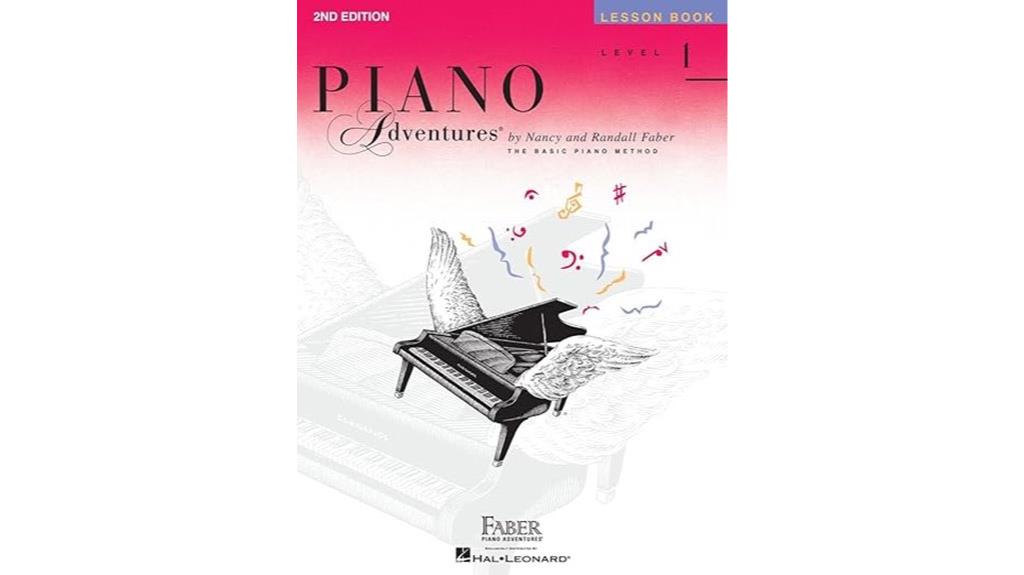
When you’re searching for a piano method that bridges the gap between beginner basics and genuine musical expression, the Piano Adventures Lesson Book – Level 1 stands as a cornerstone choice for older beginners and adults who’ve outgrown simplistic primer materials. This second edition delivers a thorough foundation in chord work and grand staff reading, frankly outpacing dated competitors like Thompson and Schaum through its modern pedagogical approach. The Faber husband-and-wife team’s creation incorporates engaging rhythm exercises, dynamic activities, and theory concepts that won’t overwhelm you, while maintaining flexible pacing perfect for students who can’t practice daily. Teachers consistently recommend this structured progression for its balance of technique development and creative musical expression.
Best For: Older beginners and adults seeking a modern piano method that balances structured progression with musical expression, especially those with busy schedules who can’t practice daily.
Pros:
- Modern pedagogical approach with engaging rhythm exercises and theory concepts that avoid overwhelming students
- Flexible pacing accommodates students with varying practice schedules and busy lifestyles
- Strong foundation in chord work and grand staff reading with structured lessons that balance technique and creativity
Cons:
- May be too advanced for very young students who would benefit from starting with the Primer level
- Requires some commitment to theory concepts that might challenge complete beginners
- Pacing may feel slow for highly motivated students who could benefit from the faster older beginner series
Teaching Little Fingers to Play: A Book for the Earliest Beginner (John Thompson’s Modern Course for Piano)

John Thompson’s “Teaching Little Fingers to Play” stands out as the definitive choice for absolute beginners, particularly children aged 6-8 who aren’t quite ready for traditional beginner methods. This methodical approach emphasizes note reading from day one, which prevents students from developing finger-number dependency that I’ve seen plague countless beginners. The book’s clear, step-by-step progression keeps songs within comfortable 5-finger positions while gradually building complexity through engaging melodies. You’ll appreciate the included audio tracks that offer dual tempos, allowing students to practice rhythm confidently. Each lesson builds foundational skills systematically, and the simple transposition exercises help students understand key signatures naturally, making this an excellent gateway to Thompson’s First Grade book.
Best For: Absolute beginners, especially children aged 6-8 and older students who need an introductory approach before tackling traditional beginner piano methods.
Pros:
- Emphasizes note reading from the beginning to prevent finger-number dependency that can hinder musical development
- Features clear step-by-step progression with engaging songs that stay within comfortable 5-finger positions
- Includes dual-tempo audio tracks and simple transposition exercises that build rhythm confidence and key signature understanding
Cons:
- Limited to 5-finger hand positions which may feel restrictive for some students eager to play more complex pieces
- Requires careful selection of supplemental materials as some related books (like “Teaching Little Fingers To Play More”) are not authored by Thompson
- May progress too slowly for students who are ready for more challenging material or have prior musical experience
My First Piano Lessons: Fun, Easy-to-Follow Instructions for Kids
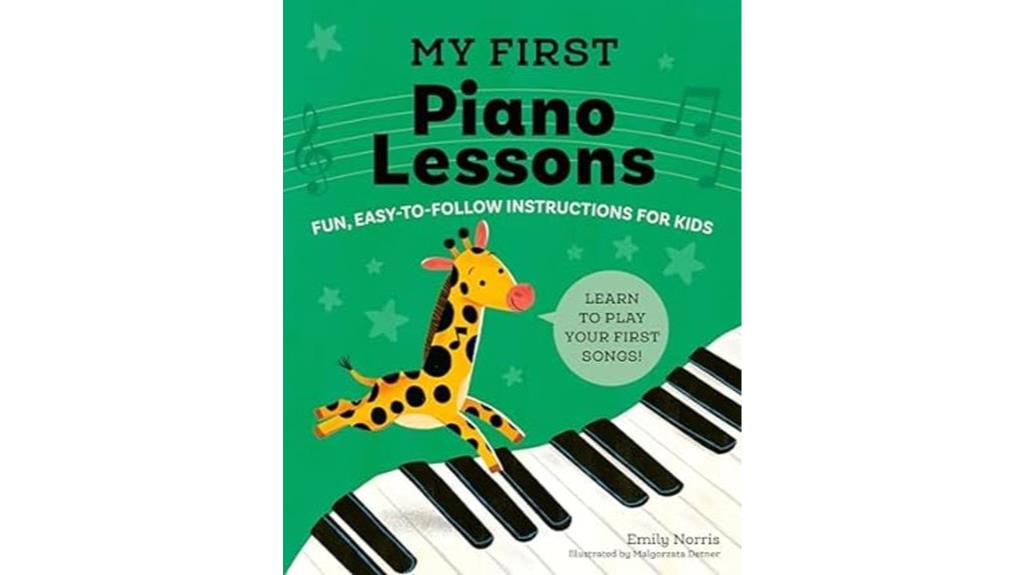
Designed specifically for children aged 5-12, “My First Piano Lessons: Fun, Easy-to-Follow Instructions for Kids” stands out as an exceptional choice for young beginners who need structured, bite-sized learning sessions that won’t overwhelm their developing attention spans. What I find particularly compelling is how this book creates a bridge between child and adult learning, with many parents discovering they’re picking up musical concepts alongside their kids. The straightforward approach builds solid music notation fundamentals while keeping lessons short enough to maintain engagement. Teachers consistently praise its simplicity, though some users note it requires basic musical understanding to be truly effective for complete beginners.
Best For: Children aged 5-12 who are beginning piano lessons, as well as parents who want to learn alongside their kids and teachers looking for a simple instructional resource.
Pros:
- Short, engaging lessons perfectly sized for young children’s attention spans
- Creates opportunities for parents and children to learn music together
- Builds solid foundation in music notation and reading skills
Cons:
- May require some basic musical understanding to be fully effective
- Not suitable for complete beginners without any prior musical knowledge
- Mixed effectiveness depending on the individual learner’s background
The Art of Teaching Piano
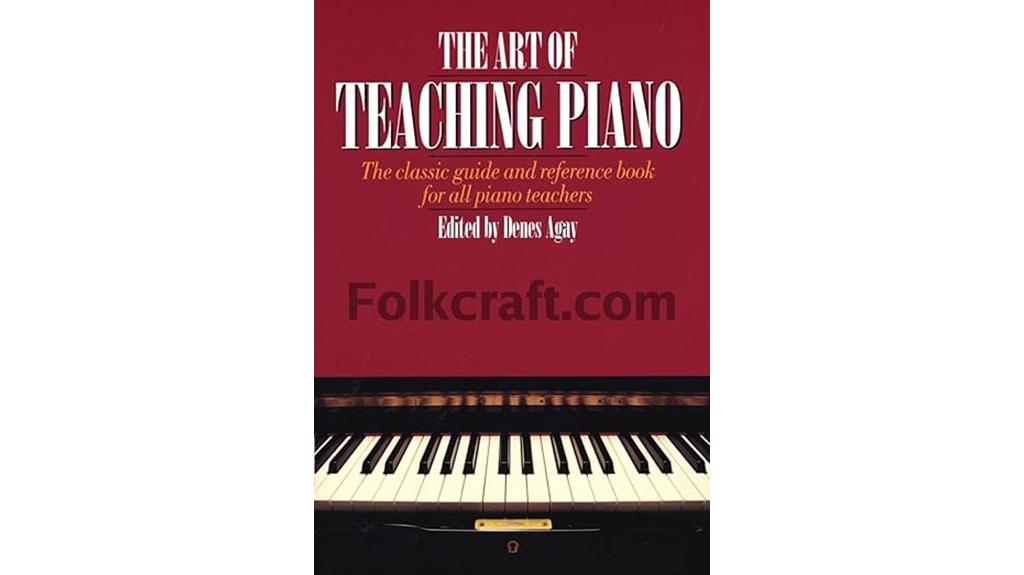
Although The Art of Teaching Piano carries copyrights from 1981 and 2004, suggesting it’s more reprint than revision, I’ve found this book remains remarkably relevant for serious piano students and teachers who crave depth over surface-level instruction. You’ll discover sophisticated insights that surpass typical student-oriented materials, making it particularly valuable for adult learners re-engaging with piano fundamentals like musical notation, scales, and rhythm. While some readers find the presentation somewhat dry, and others note limited focus on practical teaching techniques for complex concepts like pedaling, the extensive content serves as an excellent reference for lesson planning and clarifying difficult concepts across various skill levels.
Best For: Serious piano students, teachers seeking comprehensive reference material, and adult learners returning to piano who want sophisticated insights beyond typical beginner-oriented instruction.
Pros:
- Offers sophisticated content depth that remains relevant despite being decades old, surpassing typical student-oriented materials
- Serves as an excellent comprehensive reference for lesson planning and clarifying complex concepts across various skill levels
- Valuable for both private teachers as a refresher of college-level content and adult learners re-engaging with piano fundamentals
Cons:
- Presentation can be somewhat dry and less engaging for some readers
- Limited focus on practical teaching techniques and methods, particularly for complex aspects like pedaling and music theory
- More focused on what to teach rather than how to effectively teach it, which may disappoint experienced teachers seeking pedagogical strategies
John Thompsons Easiest Piano Course Part 1
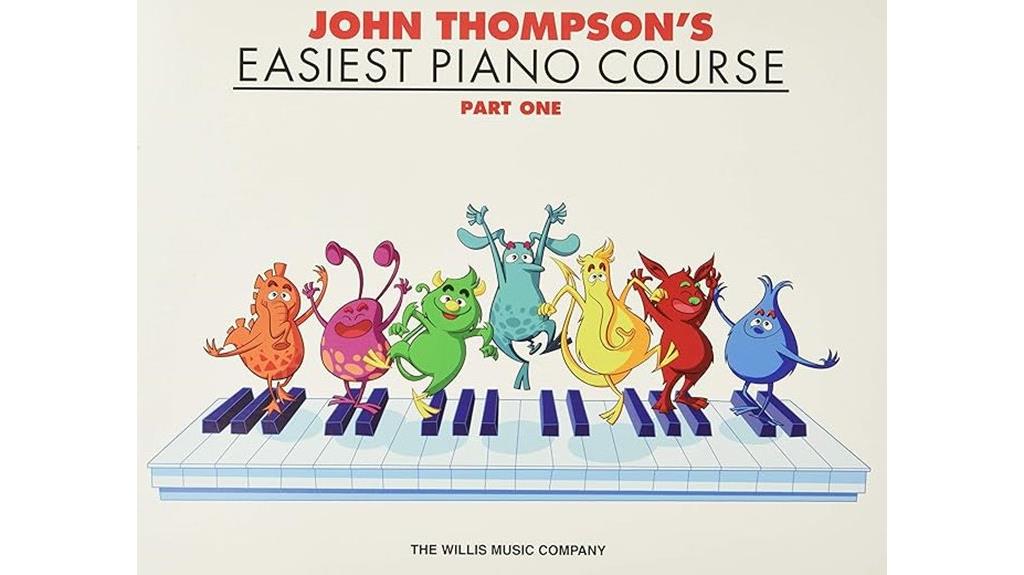
When you’re searching for a piano method that introduces note reading from day one rather than relying on finger patterns or alternative notation systems, John Thompson’s Easiest Piano Course Part 1 stands out as the gold standard for beginners aged 5-6, though I’ve seen determined 3-4 year olds tackle it successfully after some preparatory work. What I appreciate most about Thompson’s approach is how it systematically builds note recognition without overwhelming students, though you’ll need to supplement with technique exercises since fingering diagrams aren’t included. The teacher accompaniments transform otherwise basic melodies into engaging musical experiences, and while some outdated imagery exists in older editions, the core methodology remains sound for establishing fundamental reading skills.
Best For: Beginners aged 5-6 who need to learn note reading from the staff immediately, though it’s also suitable for younger children (3-4) with preparation and older beginners who don’t mind child-oriented content.
Pros:
- Introduces note reading directly from the staff without relying on finger patterns or alternative notation systems
- Systematically builds concepts slowly to prevent overwhelming students while establishing solid fundamentals
- Includes teacher accompaniments that transform basic melodies into engaging, interactive musical experiences
Cons:
- Lacks fingering diagrams which can delay proper finger technique development
- Early introduction of eighth notes and key signatures may confuse beginning students
- Initial songs may lack engagement without the accompanying materials, and older editions contain outdated imagery
Piano Adventures: Lesson Book – Primer Level, 2nd Edition | Beginner Piano Method Book
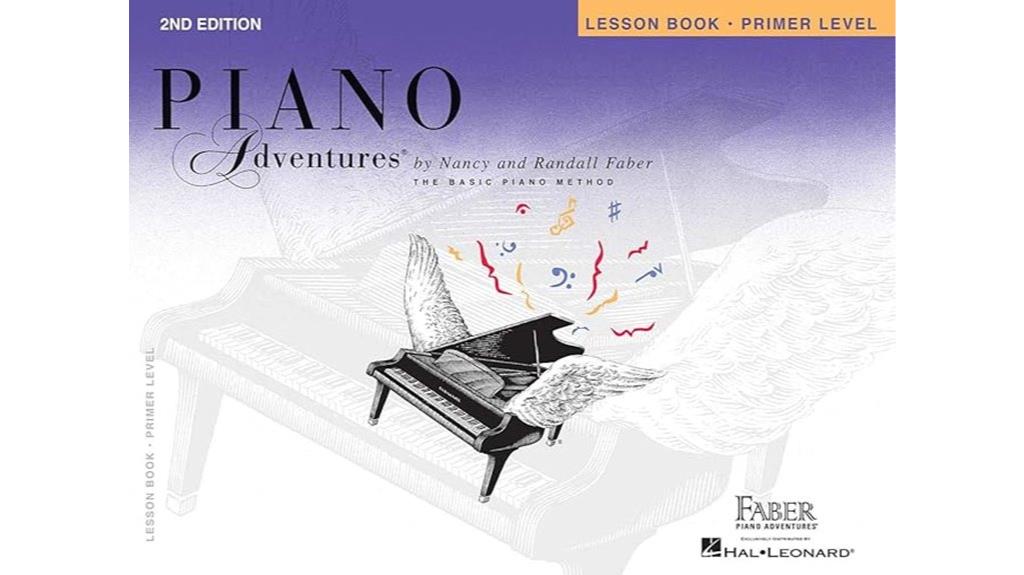
Piano Adventures: Lesson Book – Primer Level strikes me as the ideal starting point for young pianists between ages 5-9, particularly because it tackles one of the biggest challenges I’ve observed in beginner piano education: information overload. The curriculum’s brilliance lies in its black-key introduction, allowing children to recognize patterns and sounds before diving into note names, which I find reduces the typical overwhelm that drives many students away. What impresses me most is how the book systematically introduces white keys and staff reading midway through, ensuring students master 1-3 notes before adding complexity, while incorporating sight reading, ear training, and composition exercises that develop thorough musicianship from day one.
Best For: Young piano beginners aged 5-9 who need a structured, gradual introduction to piano fundamentals without overwhelming complexity.
Pros:
- Reduces information overload by starting with black keys for pattern recognition before introducing note names and staff reading
- Develops comprehensive musicianship through integrated sight reading, ear training, dexterity, and composition exercises from the beginning
- Includes engaging features like accompanying lyrics, teacher duets, and video resources that keep students motivated and excited to practice
Cons:
- Limited to primer level content, requiring additional books for continued progression beyond basic fundamentals
- Some teachers find the whimsical illustrations distracting and prefer uncolored alternatives to encourage student creativity
- Requires investment in multiple complementary books (Theory, Technique, Performance) for a truly comprehensive curriculum
Piano Scales, Chords & Arpeggios Lessons with Basic Music Theory (Book & Streaming Video)
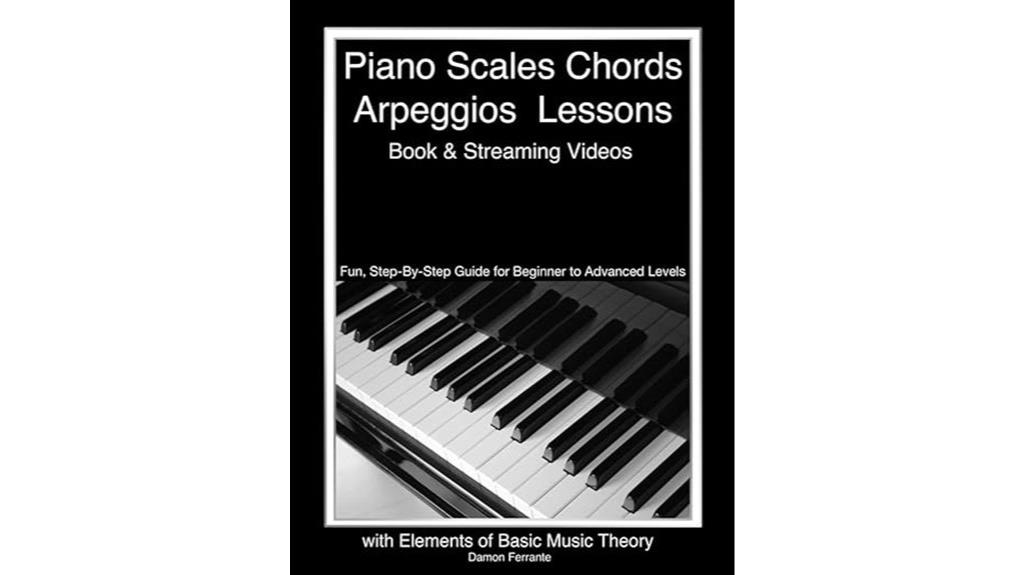
If you’re someone who’s been intimidated by traditional piano method books that either oversimplify concepts or throw you into the deep end without proper guidance, Piano Scales, Chords & Arpeggios Lessons with Basic Music Theory offers a rejuvenatingly balanced approach that bridges the gap between beginner-friendly content and serious musical education. This interactive eBook combines thorough written instruction with streaming video lessons, creating a self-paced learning environment that works whether you’re returning to piano after years away or starting completely fresh. The structured progression from Level 1 through Level 5 covers everything from basic finger positioning to advanced concepts like augmented chords and different modes, while the Kindle format eliminates page-flipping frustrations during practice sessions.
Best For: Beginner to advanced pianists seeking a comprehensive, self-paced learning resource that combines serious music theory instruction with practical video demonstrations, particularly those who want to avoid oversimplified beginner materials or need a structured refresher course.
Pros:
- Interactive eBook format with streaming video lessons eliminates page-flipping during practice and provides visual reinforcement of techniques
- Structured Level 1-5 progression covers both foundational concepts and advanced topics like augmented/diminished chords and different modes
- Balanced approach that provides serious educational value without overwhelming beginners or boring advanced players seeking a refresher
Cons:
- Requires access to streaming video capability and compatible devices for full learning experience
- Self-paced format may lack the accountability and personalized feedback of traditional in-person instruction
- May not provide enough song repertoire for those primarily interested in learning to play specific pieces rather than music theory
Factors to Consider When Choosing Piano Teaching Books
When I’m helping parents select piano teaching books, I’ve learned that several critical factors determine whether a student will thrive or struggle with their musical journey. The student’s age and current skill level must align with the book’s difficulty progression, while their individual learning style preferences—whether they respond better to visual, auditory, or kinesthetic approaches—significantly impact their engagement and retention rates. I also consider how well the method integrates music theory concepts, the quality and appeal of song selections that will motivate practice, and the availability of supplementary resources like audio tracks, digital tools, or companion workbooks that enhance the learning experience.
Age and Skill Level
Two fundamental factors determine whether a piano teaching book will succeed or fail in your learning journey: the student’s age and current skill level, both of which dramatically influence how musical concepts should be presented and absorbed.
I’ve learned that children aged 5-9 thrive with colorful illustrations, engaging stories, and bite-sized lessons that won’t overwhelm their developing attention spans. Adult beginners, however, often prefer sophisticated theoretical explanations alongside practical technique development, since they can grasp complex concepts more readily than younger students.
When selecting materials, I always assess whether the book’s pacing matches the student’s abilities—absolute beginners need gradual concept introduction through simple melodies, while returning players require progressive complexity. The learning structure must align with both cognitive development and musical readiness to maintain motivation.
Learning Style Preferences
Since everyone processes information differently, I’ve discovered that matching a piano teaching book to your specific learning style can greatly accelerate your progress and maintain long-term motivation. Visual learners should prioritize books featuring colorful layouts, detailed diagrams, and extensive chord charts that make complex concepts immediately digestible. Auditory learners benefit most from resources that include streaming video lessons, audio recordings, or QR codes linking to supplemental sound materials. Kinesthetic learners thrive with interactive workbooks that incorporate hands-on exercises, physical movement activities, and tactile learning approaches. I’ve noticed that pacing preferences vary considerably—some students prefer methodical, step-by-step progressions while others excel with rapid concept introduction. The availability of supplemental resources, including video tutorials and interactive digital components, can bridge learning style gaps and accommodate diverse preferences.
Music Theory Integration
Choosing a piano teaching book with well-integrated music theory fundamentally shapes whether students develop genuine musical understanding or merely learn to mechanically reproduce notes on a page. I’ve found that effective books seamlessly weave theoretical concepts like note reading, scales, and rhythm into practical lessons, preventing the overwhelming information dumps that discourage beginners. The best resources introduce theory gradually through structured progressions, allowing students to build foundational knowledge without feeling intimidated by complex terminology.
I particularly value books that combine theoretical exercises with hands-on playing experiences, since this approach helps students understand how theory directly applies to their music-making. When publishers include supplemental materials like online videos or worksheets, they’re acknowledging that different learners need varied reinforcement methods to grasp abstract concepts and retain essential musical structures.
Song Selection Quality
Three essential elements determine whether a piano teaching book’s song selection will captivate students or send them running to their gaming consoles: familiarity, progression alignment, and stylistic diversity. I’ve witnessed countless students light up when they recognize “Twinkle, Twinkle, Little Star” in their first lesson, building confidence through familiar melodies before tackling more challenging pieces.
The best teaching books strategically sequence songs that reinforce newly introduced concepts, ensuring each piece serves a dual purpose of entertainment and skill development. However, I’ve noticed many traditional methods suffer from outdated repertoires that fail to engage modern learners. Contemporary books increasingly offer supplementary online libraries, expanding beyond the printed page to include popular songs, movie themes, and diverse cultural selections that maintain student interest while developing technical proficiency.
Supplementary Resource Availability
When I evaluate piano teaching books, I’ve learned that supplementary resource availability often makes the difference between students who thrive and those who struggle through technical plateaus, since modern learners benefit tremendously from multi-modal approaches that extend beyond traditional printed methods. I specifically look for books that include audio examples, which help students verify their progress and match intended sounds for better self-assessment. Online video tutorials and music theory websites provide additional context that complements printed content, especially for advanced techniques not deeply covered within the book itself. Interactive components like streaming lessons or practice apps cater to different learning styles, increasing engagement for both children and adults while preventing poor habits through supplemental technique exercises.
On a final note
I’ve curated these piano teaching books based on years of experience helping students find the right learning materials, though I’ll admit my own piano skills peaked somewhere around “Chopsticks.” Whether you’re starting your musical journey at five or fifty, these resources offer structured progression, thorough theory integration, and practical techniques that’ll keep you engaged. Choose based on your current skill level, learning style preferences, and musical goals—your fingers will thank you later.

